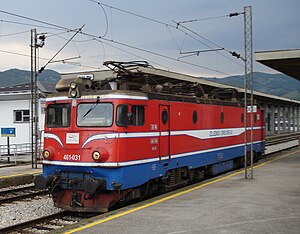JŽ series 461
| JŽ series 461 | |
|---|---|
| Number: | 103 |
| Manufacturer: | Electroputere |
| Year of construction (s): | 1971-1973; 1978-1980 |
| Axis formula : | CoCo |
| Gauge : | 1435 mm ( standard gauge ) |
| Top speed: | 120 km / h |
| Continuous output : | 5400 kW |
| Power system : | 25 kV 50 Hz ~ |
| Power transmission: | power line |
The JŽ class 461 is a heavy electric locomotive for passenger and freight trains of the former Jugoslovenske Železnice (JŽ), the design of which is based on that of the CFR class 060 EA .
history
The total of 103 vehicles, which come from the Romanian manufacturer Electroputere and are based on plans by the Swedish manufacturer ASEA, were intended for use in front of heavy trains and, above all, for use on railway lines with steep inclines, such as those in the Balkans. B. can be found on the Belgrade – Bar railway line , a Yugoslav new building project. The locomotives were delivered in two series. The first series designated as JŽ 461-0, which comprises 45 vehicles opened to traffic from 1971 to 1973 and the 58 vehicles of the second series designated as JŽ 461-1 and built from 1978 to 1980. The first order was made for 45 locomotives specifically for the requirements of the Belgrade-Bar relation, which were ordered by ŽTP-Beograd as the bearer of all investments in the new building. It was the first time that the Yugoslav Railways had ordered their own type of locomotive for a new line.
After the break-up of Yugoslavia, the Jugoslovenske Železnice split up into several successor companies, three of which, namely the Montenegrin ŽCG , the Serbian ŽS and the MŽ operating in Macedonia, use class 461 locomotives. They are used in front of passenger and freight trains. Some locomotives were also sold abroad.
Not all 461s built can still be found in operation today. Due to the slump in demand after the division, a number of locomotives have been turned off and mostly used as spare parts donors or scrapped. In addition, a number of vehicles have been destroyed in fires and accidents. They continue to form an important backbone of rail traffic in the affected countries and represent almost the only type of locomotive on the Belgrade – Bar line, which is also their main area of use.
gallery
Web links
Individual evidence
- ↑ Vidosav Novaković Zoran & Borčević 1972: Oni su gradili prugu . In Dragoljub Stojanović (ed.) 1972: Beograd-Bar : Novinsko-Izdavačko Preduzeče Duga. Pp. 133-178. Here p. 173



